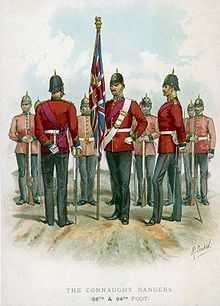Richard Simkin
Richard Simkin (1850–1926) was a British artist and illustrator of military uniforms.
Biography
Born in Herne Bay, Kent, on November 5, 1850, the son of a commercial traveller, also named Richard.[1] He spent much of his time at Aldershot, Hampshire, after marrying his wife, Harriet, in 1880, and may also have been a volunteer in the Artists Rifles. He was employed by the War Office to design recruiting posters, and to illustrate the Army and Navy Gazette. In 1901 he created a series of 'Types of the Indian Army' for the Gazette.;[2] he obtained much of the information from the Colonial and India Exhibition of 1886. During his lifetime, he, along with Orlando Norie produced thousands of watercolours depicting the uniforms and campaigns of the British Army. Simkin also contributed illustrations to numerous publications including the Boy's Own Magazine, The Graphic and others; many were published by Raphael Tuck and sons.
He died at his home a 7 Cavendish Street, Herne Bay on June 25, 1926, survived by his wife and two daughters. Today, his pictures can be seen in numerous regimental museums and his illustrations appear in regimental histories, while watercolours frequently come up for auction.
Publications
- The War in Egypt. London: George Routledge, 1883
- Our Soldiers and Sailors in Egypt. London: George Routledge, 1885
- Uniforms of the British Army, in Twelve Representative Plates. London: Halford Bros, 1886
- Military Types. London: George Berridge, 1888–1902
- Life in the Army. London: Chapman & Hall, 1889
- A Book of Soldiers. London: Perry., c. 1890
- Following the Drum. London: William Allen, c. 1890
- Where Glory Calls. The Soldier's Scrap Book. London: William Allen, c. 1890
- The Royal Military Tournament. London: Frderick Warne, c. 1890
- The Boy's Books of British Battles from 1704 to 1882. London: George Routledge, c. 1890
- Our Armies. London: Sampson Low, Marston, 1891
- British Soldiers Past and Present: Their Dress and Equipment from 1600 to Date. London: Frederick Warne, c. 1894
- Armed Europe. London: Raphael Tuck, c. 1895
- The Army. London: George Routledge, c. 1900
- The Great Powers of the World. London: Dean, c. 1900
- Soldiers of the Queen. London: Thomas Nelson, c. 1900
- Soldiers of the Century. London: Dean, 1901
- Sailors of the Century. London: Dean, 1901
Gallery
-

The Connaught Rangers
-
%2C_1891.jpg)
The King's Regiment
References
- ↑ The best biographical information on the artist is Carman, William Y. (1982). Richard Simkin's Uniforms of the British Army: The Cavalry Regiments. Exeter: Webb & Bower, pp. 9-13
- ↑ Arnold Wilson (1972). A Dictionary of British Military Painters. Leigh-on-Sea: F. Lewis
Further reading
- Carman, William Y. (1982). Richard Simkin's uniforms of the British Army: the cavalry regiments: from the collection of Captain K.J. Douglas-Morris, RN. Exeter: Webb & Bower. ISBN 0-906671-13-2
- Carman, William Y. (1985). Richard Simkin's uniforms of the British Army: Infantry, Royal Artillery, Royal Engineers and other corps: from the collection of Captain K.J. Douglas-Morris, RN. Exeter: Webb & Bower. ISBN 0-86350-031-5
- Walton, Peter S. (1981). Simkin's soldiers: the British army in 1890. 2v. Dorking, Surrey: Victorian Military Society.
External links
| Wikimedia Commons has media related to Richard Simkin. |
- Anne S. K. Brown Military Collection, Brown University Library over 350 original water-colours by Simkin
|